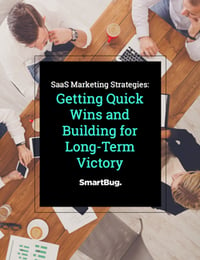
What Role Should Marketing Play in a Product-First SaaS Company?
January 21, 2019
By Jen Spencer
If you’re the leader of a product-first SaaS company, it can be easy to make the mistake of ignoring marketing and believing that it isn’t necessary for the success of your organization.
This is a common occurrence in the SaaS vertical where marketing has a tendency to be not only held at bay while the product is perfected, but flat-out ignored post-funding when initial investments are made in sales and sales alone. That is, until revenue plateaus and marketing is brought in to boost performance.
The great thing about product-first organizations is they are notoriously innovative, vision-driven, and poised to scale, because rather than gathering research from potential customers and building a product to meet their needs, a product-first company will attract customers that need the product—this is where marketing comes into play and why marketing investments must be made before building a sales team.
Marketing does more than simply put a shiny spin on your successful product. In fact, marketing has a significant role to play as your product-first SaaS company matures over time.
Build Personas to Make Sales More Efficient
One of the first marketing exercises a product-first SaaS company should engage in is the creation of personas. A buyer persona (also called marketing persona) is a representation of your target customer. By interviewing actual customers who have been attracted to and are evangelists of your product, you will learn not only demographic information but also psychographic information that, when paired with data you collect from actual product usage, will help you reach more of that target customer.
This foundational marketing research is not only immensely helpful to your individual sales representatives who will now have a general idea of who someone is and what’s important to a person before engaging in a live conversation, but this research will also make your sales organization more efficient and thus more profitable.
Encourage Customer Referrals and Promote Third-Party Reviews
The dream of a product-first SaaS company is for one user to fall in love with the product, tell his or her friends who also fall in love with the product, who tell their friends, and so on and so on. I can easily lose track of all of the consumer-based apps and SaaS products I have personally evangelized, from Stitch Fix to Instacart to my Ring doorbell. I love these products and can’t wait to tell my friends how much they will love them, too. But referrals don’t just happen, especially in B2B SaaS. Although I’m likely to be dining out with friends and fielding a compliment about my outfit that leads me to share, “It’s from Stitch Fix. My stylist totally gets me. You should try it!”—there’s not quite the same in-the-moment, organic opportunity for call tracking, HR, or sales commission software is there?
In B2B, we have to work a bit harder for those referrals, and this is where marketing can lend a helpful hand. Although you can certainly try to develop a referral program where individuals are compensated or rewarded in some manner for referring a friend, you will get far more mileage out of a third-party published customer review. A product-first SaaS company should continually survey users while in the app and then use that data to request reviews from happy customers. That one customer review can be used on your website, in email signatures, on relevant social media channels, and even in lead nurture campaigns.
Create Case Studies and Broaden Calls to Action
A good old-fashioned case study is a mainstay in any B2B sales enablement content library. We know that case studies are effective tools during a buyer’s decision stage, both when competing against another vendor and when your buyer has to sell his or her decision to purchase your product internally. Not only should marketing be creating these case studies (if you need help with this, check out The Components of an Effective Case Study and 5 Powerful Content Marketing Case Study Interview Questions), but you should also showcase these extremely valuable case studies, rather than waiting for your buyer to ask sales for them.
The be-all, end-all call to action (or CTA) for a product-first SaaS company tends to be either “Request a Demo” or “Free Trial.” Either way, you’re assuming the buyer is ready for that next step or that he or she hasn’t already experienced a demo or a trial. Marketing should experiment with case study CTAs at the end of blog articles or in the footers of emails, and they can use marketing automation technology to display case study CTAs to individuals who shouldn’t be prompted to request a demo (for example, the person who already saw a demo, has your pricing in hand, but is still trying to learn more about you online). Whether you’re using HubSpot’s smart CTAs or Marketo’s dynamic content, if you have a fairly organized contact database, you’ll be able to give your well-earned case studies the exposure they deserve.
Marketing deserves a seat at the executive table of a product-first SaaS company. Particularly in B2B SaaS, it’s through strong marketing efforts that organizations can better understand their target customers and then leverage those customers to share the benefits that your product provides.

About the author
Jen Spencer formerly oversaw all operations, executing on SmartBug's growth and market expansion strategy, which is focused on delivering superior, cutting-edge service to the company's customers and partners while continuing to invest in the people and culture that make SmartBug® a great place for employees to work and develop their careers. Read more articles by Jen Spencer.









